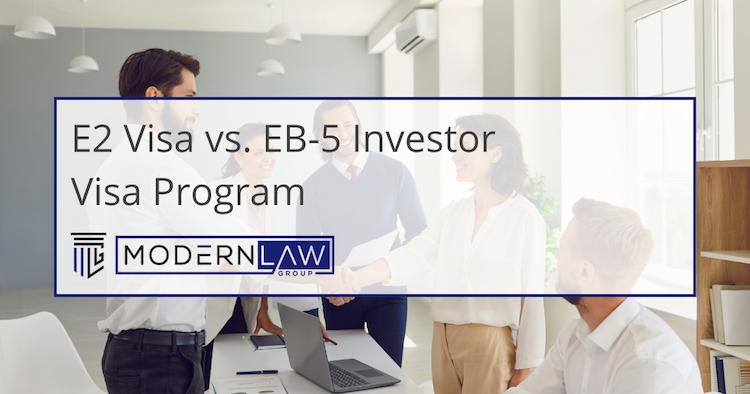E2 Visa vs. EB-5 Investor Visa Program

Here is an estimation of the two visas available for investors – E-2 and EB-5.
Learning about E-2 visas will also help those individuals involved with EB-5 investments to recognize the options some investors have.
The E-2 is a temporary visa based on a mutual business agreement between the United States and your country of nationality.
The E-2 guidelines require the U.S. business to be mainly owned by nationals of those countries who the US has agreed to conduct business with. (See if your country is in the list)
E-2 visa holders must work for the same company for which the visa has been issued. The visa applicant may be the owner, executive, manager or person with essential skills in the company’s processes, such as technology, products, etc.
Contrary to E-2 visa holders, EB-5 investors can work anywhere, attend school or enjoy retirement, as long as they are holding a status of a conditional resident, or they are at least a limited partner or a director of the new business enterprise in which they invest.
Most E-2 visas are issued for up to five years, but mutual benefit agreements between some countries mandate shorter terms, therefore, primarily two-year visas are issued with the right of renewal. While EB-5 classification paves a way for permanent residence in the US, EB-5 green cards start with a two-year conditional resident status. This is somewhere between 21-24 months, after that, provided the jobs are created and investment are maintained, investors may apply for removal of conditions on their permanent resident status.
In order to qualify for and maintain the status, EB-5 investors must create 10 full-time, permanent jobs in the US (with at least 10 employees on W-2s), excluding the investor and the temporary visa holders. The jobs must be created at the business in which the capital is invested (the company which issues the employees the W-2s).
Based on the fulfillment of those requirements the EB-5 holder(s) are issued conditional permanent residency. Once the conditional resident status is received, recent USCIS policy requires the jobs to be created within one year after filing the petition to remove conditions on the resident status.
As of November 21, 2019, the minimum investment amount has been increased.
What You Need to Know
The minimum investment in a TEA (Targeted Employment Areas) increased to $900,000 (from $500,000) corresponding to the rise of inflation.
The growth in minimum investment is one of the most substantial changes made by a directive published in the Federal Register. Ventures outside of economically struggling areas will require an investment of $1.8 million, up from $1 million.
The boost is an inflation modification on the investment amounts Congress set in 1990, according to the directive. The United States Citizenship and Immigration Services (USCIS) will now modify the amounts every five years to account for inflation. The rule went into effect on Nov. 21, 2019.
The revision has also changed how areas of high unemployment, known as targeted employment areas (TEA), are classified. Currently, each state can designate census territories that qualify as TEAs to attract foreign investment. This amendment removes that authority, giving the USCIS exclusive power to determine the locations. This also makes it tougher to designate urban neighborhoods—where some of the most sought-after investment opportunities lie—as TEAs.
An E-2 visa holder’s spouse may also obtain an E-2 visa and employment authorization in the US. Children may receive E-2 visas, but upon turning 21, they must leave the U.S. or change their status to remain in the US. As a usual option for these cases is obtaining a temporary student visa which would allow them to remain in the US.
The EB-5 green card application process permits the spouse and children under 21 to immigrate to the U.S. with the principal investor under the same immigration process.
Both E-2 and EB-5 conditional resident investors lose their status if the business fails.
If the EB-5 investment creates the needed jobs and then fails, there is an argument that particularly for investors in regional centers this is all that is needed according to the guidelines of the visa. As a matter of fact, after the EB-5 conditional resident status becomes permanent, the investor is no longer required to maintain the investment in the US.
What about transitioning from an E-2 visa to an EB-5? After admission as an E-2 visa holder, some can increase their investment in their E-2 enterprise and prove their investment will create 10 jobs and apply for an EB-5 conditional green card.
While this may seem to be a simple process, it must be done carefully from the beginning, particularly as it pertains to meeting the EB-5 financing and job-creation requirements. Retained earnings generated by the E-2 company are not allowed to be used to meet the investment requirements for the EB-5. Moreover, the investor must be able to prove that 10 new US jobs have already been created or will be created before the expiration of the two-year conditional permanent residency that will be granted.
In conclusion, understating the EB-5 and E-2 criteria will help investors choose the best options for them and their family. While the time to obtain the E-2 may be shorter, and the investment amount is much less than the EB-5 green card, an E-2 remains a temporary visa and there must be a US agreement with your country.
For many it is preferable to immigrate to the U.S. via the EB-5 because, as we have seen, economies rise and fall, countries can become insecure, and visa rules change over time, whether we look at recent history or back to 1812, when the oldest such treaty was entered into with the United Kingdom.
To better understand which option is best for you, feel free to contact our office for legal advice.









